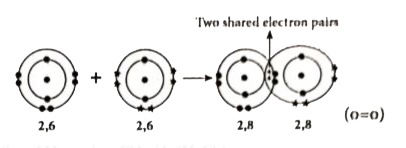Give an example for each of the following statements.
a. a compound in which two Covalent bonds are formed
b. a compound in which one lonic bond is formed
c. a compound in which two Covalent and one Coordinate bonds are formed
d. a compound in which three covalent bonds are formed.
e. a compound in which Coordinate bond is formed
Text Solution
a. Formation of oxygen molecule (O2)
Each oxygen atom has six valence electrons (2,6). These two atoms achieve a stable electronic configuration (octet) by sharing two pair of electrons. Hence a double bond is formed in between the two atoms, 
(b) b. Formation of Magnesium Chloride (MgCl2) Magnesium Chloride (MgCl2) is an ionic compound formed when the magnesium form loses two electrons to gain the noble state which is accepted by chloride ion.

c. Formation of coordinate covalent bond between NH3→BF3 molecules NH3→BF3 is a compound formed by coordinate covalent bonding. Here one pair of electrons from ammonia molecule is shared with electron deficit boron trifluoride. This type of bonding is also known as Dative bond.

d. Formation of nitrogen molecule (N2) Nitrogen molecule (N2) is formed by three covalent bonds where three pairs of electrons are shared between the two to acheive a stable configuraton.

(e) c. Formation of coordinate covalent bond in ammonium lon (NH4+)
In ammonia molecule the central nitrogen atom hus five valence electrons (2.5) among which three electrons are shared with three hydrogen atoms and still it has an unshared lone pair of electrons. This lone pair electrons are donated to a Hydrogen ion and thus a N-H coordinate covalent bond is formed in ammonium ion molecule (NH4+)).
|
Updated on:21/07/2023
Related Playlists
- BOOK - FULL MARKSCHAPTER - CHEMICAL BONDINGEXERCISE - In-Text Problems4videos
CHEMICAL BONDING
- BOOK - FULL MARKSCHAPTER - CHEMICAL BONDINGEXERCISE - Additional Questions (I. Short answers questions)4videos
CHEMICAL BONDING
- BOOK - FULL MARKSCHAPTER - CHEMICAL BONDINGEXERCISE - Exercise (II. Answer in brief)14videos
CHEMICAL BONDING
- BOOK - FULL MARKSCHAPTER - CARBON AND ITS COMPOUNDSEXERCISE - ACTIVITY1videos
CARBON AND ITS COMPOUNDS
- BOOK - FULL MARKSCHAPTER - MATTER AROUND USEXERCISE - ADDITIONAL QUESTION (ANSWER THE FOLLOWING IN DETAIL)5videos
MATTER AROUND US
Similar Questions
The compound which has covalent bond is
View SolutionThe compound which contains both covalent and coordinate bond is
View SolutionThe compound which contains both covalent and coordinate bond is
View SolutionThe compound used in the treatment of lead poisoning is :
View SolutionCoordinate covalent compounds are formed by
View SolutionWhich compound has electrovalent, covalent and coordinate bond.
View SolutionWhich of the follwing forms covalent compound?
View SolutionWhich of the follwing forms covalent compound?
View SolutionAccording to octet rule the compound which contain ioinc, covalent and coordinate bonds
View SolutionAccording to octet rule the compound which contain ioinc, covalent and coordinate bonds
View Solution

